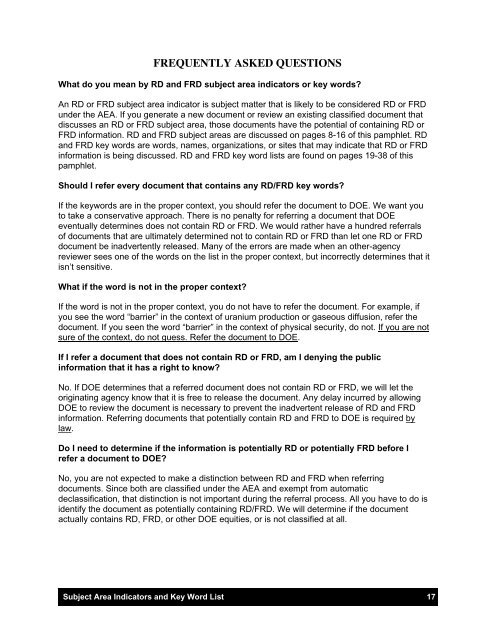U.S. Department of Energy - OSTI
U.S. Department of Energy - OSTI
U.S. Department of Energy - OSTI
You also want an ePaper? Increase the reach of your titles
YUMPU automatically turns print PDFs into web optimized ePapers that Google loves.
FREQUENTLY ASKED QUESTIONS<br />
What do you mean by RD and FRD subject area indicators or key words?<br />
An RD or FRD subject area indicator is subject matter that is likely to be considered RD or FRD<br />
under the AEA. If you generate a new document or review an existing classified document that<br />
discusses an RD or FRD subject area, those documents have the potential <strong>of</strong> containing RD or<br />
FRD information. RD and FRD subject areas are discussed on pages 8-16 <strong>of</strong> this pamphlet. RD<br />
and FRD key words are words, names, organizations, or sites that may indicate that RD or FRD<br />
information is being discussed. RD and FRD key word lists are found on pages 19-38 <strong>of</strong> this<br />
pamphlet.<br />
Should I refer every document that contains any RD/FRD key words?<br />
If the keywords are in the proper context, you should refer the document to DOE. We want you<br />
to take a conservative approach. There is no penalty for referring a document that DOE<br />
eventually determines does not contain RD or FRD. We would rather have a hundred referrals<br />
<strong>of</strong> documents that are ultimately determined not to contain RD or FRD than let one RD or FRD<br />
document be inadvertently released. Many <strong>of</strong> the errors are made when an other-agency<br />
reviewer sees one <strong>of</strong> the words on the list in the proper context, but incorrectly determines that it<br />
isn’t sensitive.<br />
What if the word is not in the proper context?<br />
If the word is not in the proper context, you do not have to refer the document. For example, if<br />
you see the word “barrier” in the context <strong>of</strong> uranium production or gaseous diffusion, refer the<br />
document. If you seen the word “barrier” in the context <strong>of</strong> physical security, do not. If you are not<br />
sure <strong>of</strong> the context, do not guess. Refer the document to DOE.<br />
If I refer a document that does not contain RD or FRD, am I denying the public<br />
information that it has a right to know?<br />
No. If DOE determines that a referred document does not contain RD or FRD, we will let the<br />
originating agency know that it is free to release the document. Any delay incurred by allowing<br />
DOE to review the document is necessary to prevent the inadvertent release <strong>of</strong> RD and FRD<br />
information. Referring documents that potentially contain RD and FRD to DOE is required by<br />
law.<br />
Do I need to determine if the information is potentially RD or potentially FRD before I<br />
refer a document to DOE?<br />
No, you are not expected to make a distinction between RD and FRD when referring<br />
documents. Since both are classified under the AEA and exempt from automatic<br />
declassification, that distinction is not important during the referral process. All you have to do is<br />
identify the document as potentially containing RD/FRD. We will determine if the document<br />
actually contains RD, FRD, or other DOE equities, or is not classified at all.<br />
Subject Area Indicators and Key Word List 17
















